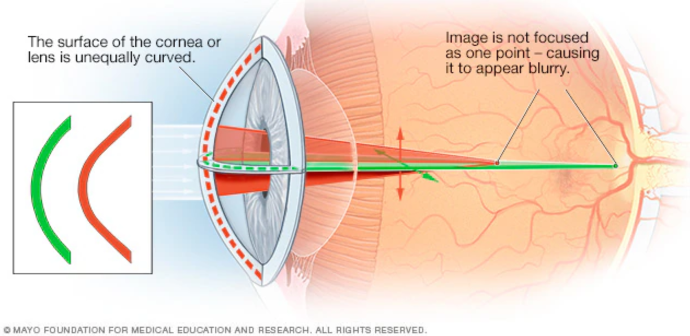Astigmatism
What is Astigmatism?
To grasp the concept of astigmatism, it is beneficial to envision the normal eye as perfectly rounded, resembling a basketball. However, in the case of astigmatism, the eye takes on an egg- or oval-shaped form similar to that of an American football.
There are two primary types of astigmatism: horizontal astigmatism, where the eye is wider than it is tall, and vertical astigmatism, where the eye is taller than it is wide. Additionally, irregular or diagonal astigmatism can also occur.
With astigmatism, the irregular shape of the eye leads to blurry vision at both near and far distances.
This occurs because light rays entering the front of the eye fail to refract or bend correctly, causing them to either fall short of the retina or go beyond it, resulting in blurred vision.

What causes Astigmatism?
The underlying cause of astigmatism lies in the irregular shape of the cornea or lens, deviating from the usual form. Astigmatism is a prevalent condition, affecting approximately one in three individuals. The exact reasons behind the variations in corneal or lens shape among people remain unknown to doctors. However, they have identified that the risk of developing astigmatism is hereditary, passed down from parents.
Astigmatism is often present from birth and can coexist with conditions such as nearsightedness or farsightedness.
People can also get astigmatism from:
- Eye Disease
- Eye Injury
- Previous Eye surgery
- Eye rubbing and thus is commonly associated with allergies or eczema.
It is a myth that reading in low light or sitting very close to the television causes astigmatism or makes it worse.
What are symptoms of Astigmatism?
Astigmatism symptoms may include:
- blurry vision or areas of distorted vision
- eyestrain
- headaches
- frequent eye rubbing
- light sensitivity
- squinting to try to see clearly, or
- eye discomfort
Experiencing these symptoms does not necessarily indicate the presence of astigmatism. To determine the underlying cause of these symptoms, it is advisable to undergo a comprehensive eye exam with our team. It is important to note that children may not be aware of their blurry vision, and they are unlikely to voice complaints about blurred or distorted vision. Regular eye examinations are essential in identifying and addressing any vision issues they may have.
But without treatment, astigmatism can:
- Impact a child's performance in school and sports
- In worse cases of astigmatism can lead to amblyopia (lazy eye) and vision loss
This is why early childhood eye examinations are so important.

How can we help?
Astigmatism Diagnosis
Our Optometrist can diagnose astigmatism during a comprehensive eye exam. Testing may include:
- Eye chart. You will be asked to read letters on an eye chart. This tests for visual acuity or sharpness of your vision at certain distances.
- Phoropter. During the examination, you will peer through a sizable binocular-like device and indicate to your doctor which letters appear clearer to you. Based on your responses, the doctor will then prescribe corrective measures to optimise your vision clarity.
- Autorefractor. This device also helps measure your astigmatism or other refractive error.
- A keratometer measures the curve of your cornea.
Often it's not pronounced enough to require corrective action. When it is, treatment options are corrective lenses or surgery.
How Is Astigmatism Corrected?
- Glasses or Contact lenses. Astigmatism can be corrected through the use of glasses or contact lenses. These visual aids function by redirecting light onto the retina at the back of the eye, resulting in improved clarity of vision. When it comes to contact lenses for astigmatism, there are two primary types available: toric soft lenses and RGP (rigid gas permeable) lenses. In cases of more severe astigmatism, RGP lenses may be the preferred option for optimal vision correction.
- Laser Refractive Eye Surgery. Procedures such as LASIK utilise a laser to reshape the cornea, thereby modifying the way light travels through it. This surgical approach aims to improve the refractive properties of the cornea, leading to clearer vision and reduced astigmatism.
There is no best way to correct your astigmatism—the most appropriate correction is one that best suits your vision needs and lifestyle. You can discuss your options in more detail after your exam.
What can I do so it doesn’t get worse?
- Wear corrective lenses or contact lenses.
- Get regular comprehensive eye exams to monitor any changes in your vision and prescribe necessary corrective lenses. Our Optometrist will recommend an appropriate review period for you. If you have any visual changes, see us as soon as possible to determine whether your astigmatism may be getting worse.
- Avoid eye rubbing. Eye rubbing is one of the common ways astigmatism can worsen over time. Underlying conditions such as dry eye, allergic conjunctivitis and eczema should be treated to avoid tendency for eye rubbing.
Come and see us today to make sure you are not suffering from astigmatism and start your journey to optimal eye health today.
We strive to give you great vision for your lifestyle.
References:
Boyd, K. (2022) What is astigmatism? symptoms, causes, diagnosis, treatment, American Academy of Ophthalmology. Available at: https://www.aao.org/eye-health/diseases/what-is-astigmatism
Astigmatism Mayo Clinic. Available at: https://www.mayoclinic.org/diseases-conditions/astigmatism/symptoms-causes/syc-20353835
Sanfilippo, P.G. and Yazar, S. (2007) Distribution of astigmatism as a function of age ... - wiley online library, Distribution of astigmatism as a function of age in an Australian population. Available at: https://onlinelibrary.wiley.com/doi/10.1111/aos.12644.
LG;, R.S.M. (2006) A review of Astigmatism and its possible Genesis, Clinical & experimental optometry. Available at: https://pubmed.ncbi.nlm.nih.gov/17177660/
Woltsche N;Werkl P;Posch-Pertl L;Ardjomand N;Frings A; Astigmatism,Available at: https://pubmed.ncbi.nlm.nih.gov/30783746/